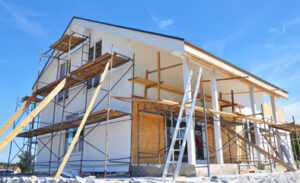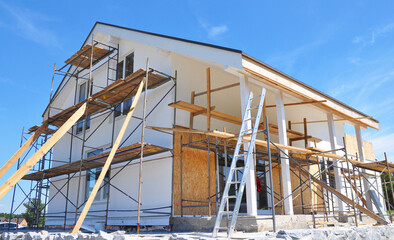Stucco Repair Philadelphia is a simple process that can fix many minor problems with stucco surfaces. However, a home that requires remediation is a much bigger task.
Begin by inspecting the damaged areas to determine if underlying issues are present. Loose stucco feels spongey and bulges outward. Tap with a soft hammer and listen for hollow sounds indicating loose lath.
Cracks in stucco usually don’t indicate structural problems, but they can happen for many reasons. They can result from damaged or improper framing, soil movement like slope creep or expansive soils, earthquakes, house settling, and strong winds from tornadoes or cyclones.
The most common cracks are the hairline variety that don’t extend past a quarter inch in size. They’re not a cause for concern and can be filled in to prevent them from expanding.
Larger cracks may indicate a different type of problem and should be carefully inspected. They can be caused by foundation problems, soffit issues, and other structural problems that should be repaired by a professional.
If they extend up through the stucco or into a window or door frame, it could be a sign of moisture intrusion. Moisture can lead to wood rot, mold, and other serious issues that should be addressed by a qualified masonry contractor.
Usually, these types of cracks can be fixed by using a specialized elastomeric coating to bridge and seal the gap. It’s important to note that the crack will most likely recur unless the underlying cause of the problem is repaired.
Stains can appear in a wide range of colors and sizes, but the good news is that most are very easy to fix. The first step is to clean the stained area thoroughly and allow it to dry. Next, choose a stain that’s appropriate for the surface to be covered and follow the product’s instructions to apply it.
Most stains can be removed with a pressure washer, but more serious ones, like water stains or rust, may require a mild acid wash. Finally, a fresh coat of exterior paint will hide and protect the repair.
Holes are a little more complicated than cracks, but they can also be easily repaired. Loose stucco often bulges and feels spongey to the touch. It needs to be chiseled loose before patching. Be careful not to damage the underlying lath supports with your hammer and cold chisel, as it can be very dangerous. Examine the metal sheeting uncovered and determine if it is salvageable. If not, replace it with a new piece of metal mesh.
Holes
Holes left behind by drill bits or tin snips can be a significant problem on your stucco exterior if not properly repaired. It’s important to repair these holes as soon as possible so that water and other elements don’t seep through them and damage your home. The first step is assessing the condition of the hole and surrounding area. If the underlying mesh or tar paper is damaged, it will need to be replaced before you start your repair. This will ensure that the stucco adheres to a solid base. Once the hole has been repaired, a layer of house wrap will need to be applied as well. Using tin snips, cut a piece of new wrap the size of the damaged area and secure it with a staple gun. It’s a good idea to overlap the wrap by about an inch on the margins that were left intact. Once the new wrap has been secured, apply a coat of acrylic exterior caulk around the perimeter to seal any gaps.
If the hole is relatively small and the surrounding finish doesn’t have any blemishes, you may not need to do anything more than apply a layer of acrylic paint that matches your home’s exterior color. Larger holes and cracks will require more extensive repairs, which may include using a stucco patching product.
To make this easier, Antonio DiSilva of MJM Masonry recommends using a pre-mixed stucco patch like Quikrete Stucco Patch. This will eliminate the need to mix the product, which can be messy. You can find this product at any home improvement store.
Start by cleaning the surface of the hole with a wire brush (a small automotive type is ideal) and blowing out the area to remove any loose particles that can adversely affect the bonding of the patch materials. Afterwards, you can start to work on the actual repair.
Once you have applied the patch material, use a putty knife to smooth it out and create a texture that blends with the existing finish of your stucco wall. Once you are happy with the result, allow it to dry for about 72 hours before applying a second and final layer of stucco patching material.
Cracked Lath
If you notice cracks forming in patterns that aren’t hairline or sporadic, it may be time to call in the pros. This type of cracking is a sign that the lath underneath needs to be re-secured or replaced altogether. This can be a more serious repair than simply patching cracks, but it’s one that can be prevented by properly installing the lath to begin with.
Moisture is another major reason for stucco cracking. When moisture enters a wall, it causes wood rot and damage to the OSB or plywood sheathing, headers, studs, and other framing members. If the sheathing and framing aren’t repaired, the cracks will spread, possibly resulting in structural damage to your home.
When the lath or sheathing is rotted, it can no longer support the stucco, leading to cracks in the finished surface of your house. If this isn’t addressed, it can cause the stucco to crumble or fall off, which can result in expensive repairs for your home.
Hairline cracks can be repaired by using an elastomeric caulk. This seals the cracks and helps prevent future problems like water penetration and mold. You’ll want to be sure you use the right caulk for your stucco, though, since different types of stucco require specific formulas.
Larger cracks are a more serious problem and should be addressed by a professional. Often, these cracks are caused by seismic movements or by the house settling or shifting over time. To prevent these cracks, your home should be properly supported with a push pier or helical pier system. This helps your house reach its practical maximum recovery and stabilizes it against expansive soil.
Patterned cracks are more often caused by the lath itself, whether it wasn’t nailed down correctly or came loose somehow. Meshing these areas with mesh and a light base coat will usually stop them from reappearing, but it’s not always easy to blend these patches in with the existing finish. There are also many installation methods that can reduce these cracks, including control joints, casing beads, and corner beads. When these are installed correctly, they help to evenly distribute the stress of the building and reduce the overall cracking risk.
Mold
Mold growth on stucco is a serious issue that should not be ignored. It can be a sign of underlying problems, such as moisture intrusion or poorly installed sheathing and framing. If not addressed, it can lead to costly repairs that require the removal of the sheathing, framing, and insulation and replacement with new materials.
Moisture can enter the walls of a home through gaps around doors and windows, cracks in the stucco, and other areas where water may seep into the wall cavity. Eventually, this creates a breeding ground for mold, which feeds on organic material like leaves and other plant life that fall against the wall or onto it from nearby trees or bushes. Mold in stucco can be hard to detect because it looks just like normal dirt and stains on the exterior of your home. If the mold on your stucco resists bleaching or keeps coming back, it’s time to call a professional.
If you’re able to clean the mold off of your stucco, you should be able to repair the damage. Begin with a thorough inspection of your home to check for signs of moisture damage, especially around the windows and doors. Moisture meters can be inserted into suspected areas to determine the level of moisture in the walls and how much work is required for remediation.
Once you’ve identified the area of your stucco that needs to be repaired, cover the area with something, such as a tarp, to prevent dust and debris from falling on other parts of your house. Next, chop off the damaged stucco using a hammer and chisel, leaving lath around the edges to tie the new stucco to the old.
Once the surface of your stucco is smooth, you can apply the brown coat. This is the most difficult phase of the process, and it requires a lot of skill and care to get right. The brown coat helps to even out the thickness of the stucco as well as fill in any cracks that might occur during installation.
If your stucco needs to be repaired, it’s important to work with a reputable contractor that has the experience and knowledge to do the job right. Stucco remediation is more than just putting a patch on a leaky pipe. It involves removing and replacing the drywall, sheathing, insulation, and framing that are affected by water damage and mold. This is a bigger project that requires an extensive inspection and moisture metering to ensure that any underlying problems are completely addressed.
